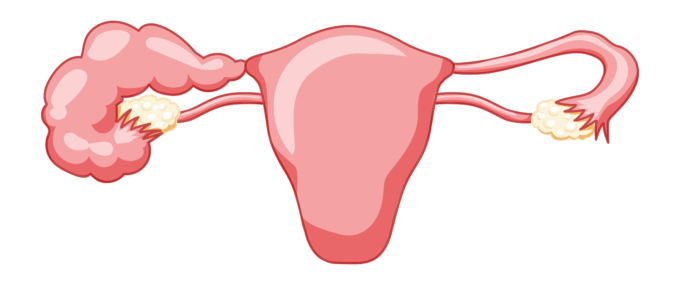Hydrosalpinx is a condition in which one or both of the woman’s fallopian tubes are blocked and dilated due to an accumulation of fluid inside, generally as a result of a previous infection. The fluid produced by the hydrosalpinx is toxic to embryos.
In vitro fertilization (IVF) is the treatment of choice when suffering from hydrosalpinx, thanks to the fact that it makes it possible to aspirate the eggs directly from the ovaries, fertilizing them in a laboratory, and place the embryos with greater implantation power in the woman’s uterus.

General description
Hydrosalpinx is a condition in which one or both of the woman’s fallopian tubes are blocked and dilated due to an accumulation of fluid inside, generally as a result of a previous infection.
The condition is often bilateral and even when hydrosalpinx affects only one tube, the one on the other side is also usually abnormal.
Hydrosalpinx causes infertility because the blockage in the fallopian tubes prevents the sperm from meeting the egg and fertilizing it. Likewise, it makes it impossible for the fertilized egg to move from the ovary to the uterus, which increases the risk of ectopic pregnancy.
Main symptoms
Although a large number of patients with hydrosalpinx do not present symptoms and this is in most cases an incidental finding, hydrosalpinx is characterized by causing:
- Chronic or recurring pelvic pain
- Intermittent abdominal discomfort
- Infertility

Causes
Hydrosalpinx is often caused by chronic infections of the fallopian tubes, which in most cases are caused by sexually transmitted diseases such as gonorrhea or chlamydia, which can go undetected for years and slowly damage the tubes.
Other causes of infection include:
- Previous surgeries (particularly surgeries on the fallopian tubes, such as tubal recanalization)
- Pelvic adhesions
- Intrauterine devices (IUDs) are used as a contraceptive method
- Endometriosis
- History of ectopic pregnancy
Diagnosis
In addition to a physical examination and review of the patient’s medical history, there are three ways to diagnose hydrosalpinx:
- Gynecological vaginal ultrasound: This allows you to observe the fluid inside the tube and is an easy procedure to perform.
- Hysterosalpingography (HSG): This is an x-ray procedure in which contrast dye is injected into the uterine cavity to examine the degree of opening of the fallopian tubes. If the tubes are patent, fluid spills out of their ends. If they are blocked, they look thicker than normal and the liquid is trapped, giving them a sausage-like appearance.
- Laparoscopic surgery: A small incision is made in the woman’s abdomen through which a device containing a tiny video camera is inserted, which is used to examine the fallopian tubes for dilations.
Laparoscopy is usually performed under general anesthesia and, like hysterosalpingography, carries risks for the patient. For this reason, at Ingenes we recommend gynecological vaginal ultrasound, which does not carry any risk, is faster, less invasive, and equally effective in diagnosing hydrosalpinx.
Treatments to achieve pregnancy
In vitro fertilization (IVF) is the treatment of choice because it makes it possible to aspirate the eggs directly from the ovaries, fertilizing them in a laboratory, and place the embryos with greater implantation power in the woman’s uterus.
This prevents passage through the fallopian tubes, making them no longer essential and offering a greater chance of pregnancy than any other available treatment.
Hydrosalpinx can have adverse effects on the success rates of in vitro fertilization due to the presence of substances toxic to the embryo, so in most cases, a hysteroscopy is performed to perform an occlusion (closure of tubal orifices), which prevents the passage of fluid into the uterine cavity and the consequent damage to the embryo. In the most severe cases (when the hydrosalpinx is greater than 3 centimeters) the damaged tube is removed through laparoscopy before starting treatment.

Learn about hydrosalpinx directly from one of our assisted reproduction specialists.
At Ingenes, we are committed to providing you with the specialized attention and care you deserve on your path to motherhood. If you are considering fertility treatment or have questions about your reproductive health, we invite you to schedule an appointment with our specialists. Together, we will explore the options and find the path that is best for you. Schedule your appointment today and take the first step toward your dream of starting a family.


